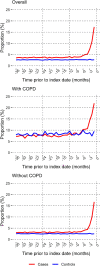Antibiotic use prior to a lung cancer diagnosis: a population-based study
- PMID: 33754218
- PMCID: PMC8089077
- DOI: 10.1007/s10552-021-01413-5
Antibiotic use prior to a lung cancer diagnosis: a population-based study
Abstract
Aim: To examine patterns of recent pre-diagnostic fillings of antibiotics as an indicator of early symptoms of lung cancer.
Methods: Individuals diagnosed with lung cancer (cases) in 2009-2016 were identified in the Swedish National Lung Cancer Register, a population-based register, and randomly matched with up to five individuals free of lung cancer (controls) from the general population. Conditional logistic models were used to estimate odds ratios for the association between lung cancer and a recent history of filled antibiotic prescriptions.
Results: The study included 27,017 cases and 129,355 controls. The likelihood of recent exposure was approximately two times higher in cases compared to controls. The magnitude of the effect size became more pronounced with proximity to the diagnosis of lung cancer and an increasing number of filled prescriptions. While the magnitude of the effect size did not differ by sex or educational level, it became attenuated with increasing age. There was no evidence supporting a trend in the magnitude of the effect size for the association between lung cancer and a history of repeated fillings by cancer stage.
Conclusion: Lung cancer was associated with an increased likelihood of a recent history of filled antibiotic prescriptions. However, there was no evidence of an association between repeated fillings and a diagnostic delay, as reflected by stage. Our findings underscore the importance of clinical reassessment to rule out lung cancer following pneumonia treatment, especially for patients with multiple treatment cycles.
Keywords: Antibiotics; Early symptoms; Lung cancer; Pneumonia; Sweden.
Conflict of interest statement
Lukas Löfling, Shahram Bahmanyar, and Helle Kieler are employees at the Centre for Pharmacoepidemiology at Karolinska Institutet, which receives funding from several entities (pharmaceutical companies, regulatory agencies, and contract research organizations). Mats Lambe declares stock ownership in Pfizer and Astra Zeneca. Gunnar Wagenius has no conflict of interest to declare. The funding bodies had no role in the data collection and analysis and were not involved in the interpretation of results, writing, revision, or approval of the manuscript.
Figures



Similar articles
-
Antibiotics use and risk of amyotrophic lateral sclerosis in Sweden.Eur J Neurol. 2019 Nov;26(11):1355-1361. doi: 10.1111/ene.13986. Epub 2019 Jun 7. Eur J Neurol. 2019. PMID: 31087715
-
Educational level and management and outcomes in non-small cell lung cancer. A nationwide population-based study.Lung Cancer. 2019 May;131:40-46. doi: 10.1016/j.lungcan.2019.03.004. Epub 2019 Mar 7. Lung Cancer. 2019. PMID: 31027696
-
Use of Phosphodiesterase Type 5 Inhibitors for Erectile Dysfunction and Risk of Malignant Melanoma.JAMA. 2015 Jun 23-30;313(24):2449-55. doi: 10.1001/jama.2015.6604. JAMA. 2015. PMID: 26103029
-
Socioeconomic position and survival after lung cancer: Influence of stage, treatment and comorbidity among Danish patients with lung cancer diagnosed in 2004-2010.Acta Oncol. 2015 May;54(5):797-804. doi: 10.3109/0284186X.2014.1001037. Epub 2015 Mar 12. Acta Oncol. 2015. PMID: 25761702
-
Frequent Use of Antibiotics Is Associated with Colorectal Cancer Risk: Results of a Nested Case-Control Study.Dig Dis Sci. 2016 Jan;61(1):255-64. doi: 10.1007/s10620-015-3828-0. Epub 2015 Aug 20. Dig Dis Sci. 2016. PMID: 26289256 Free PMC article.
Cited by
-
The Effects of Antibiotics on the Development and Treatment of Non-Small Cell Lung Cancer.Pol J Microbiol. 2023 Dec 16;72(4):365-375. doi: 10.33073/pjm-2023-047. eCollection 2023 Dec 1. Pol J Microbiol. 2023. PMID: 38103006 Free PMC article.
-
Association Between Antibiotic and Outcomes of Chemoimmunotherapy for Extensive-Stage Small Cell Lung Cancer: A Multicenter Retrospective Study of 132 Patients.Thorac Cancer. 2025 Jan;16(1):e15492. doi: 10.1111/1759-7714.15492. Epub 2024 Nov 20. Thorac Cancer. 2025. PMID: 39566958 Free PMC article.
-
Antibiotic adoption effects on nutrition and quality of life in lung cancer patients undergoing radiotherapy and chemotherapy: A meta-analysis.Technol Health Care. 2024;32(6):4515-4536. doi: 10.3233/THC-240660. Technol Health Care. 2024. PMID: 39520156 Free PMC article.
References
-
- Löfling L, et al. Clinical characteristics and survival in non-small cell lung cancer patients by smoking history: a population-based cohort study. Acta Oncol. 2019;58(11):1618–1627. - PubMed
-
- Karl-Gustav Kölbeck and H. Almer. Regionalt Vårdprogram - Lungcancer [Regional Care Program - Lung Cancer]. 2018 [cited 2019 20190114]; Available from: http://www.viss.nu/Handlaggning/Vardprogram/Andning/Lungcancer/.
-
- National Health Service (NHS). Lung cancer symptoms. 2019 20190815 [cited 2019 190827]; Available from: https://www.nhs.uk/conditions/lung-cancer/symptoms/#.
-
- Zhang H, Garcia Rodriguez LA, Hernandez-Diaz S. Antibiotic use and the risk of lung cancer. Cancer Epidemiol Biomarkers Prev. 2008;17(6):1308–1315. - PubMed
MeSH terms
Substances
Grants and funding
LinkOut - more resources
Full Text Sources
Other Literature Sources
Medical

